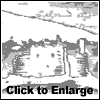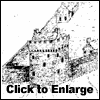|
Lochwood Castle
 Lochwood Tower (or Lochwood Castle), the seat of the Johnstone Clan,
lies a few miles southwest of Moffat in Dumfriesshire, Scotland. It
is located in upper Annandale, the valley of the Annan River, which
originates in the Devil's Beef Tub north of Moffat and flows south some
thirty miles to the Solway Firth near Annan. Lochwood is situated in the
Parish of Johnstone, which takes its name from
(or gave its name to) Lochwood's owners. The name "Lochwood" is derived
from a forest (wood) near an ancient lake (loch), which later became a bog
known as Lochwood Moss. Parts of the forest still exist in the form of thousand-year-old oak trees
(the "Royal Oaks") which grow adjacent to the Lochwood Tower site.
Lochwood Tower (or Lochwood Castle), the seat of the Johnstone Clan,
lies a few miles southwest of Moffat in Dumfriesshire, Scotland. It
is located in upper Annandale, the valley of the Annan River, which
originates in the Devil's Beef Tub north of Moffat and flows south some
thirty miles to the Solway Firth near Annan. Lochwood is situated in the
Parish of Johnstone, which takes its name from
(or gave its name to) Lochwood's owners. The name "Lochwood" is derived
from a forest (wood) near an ancient lake (loch), which later became a bog
known as Lochwood Moss. Parts of the forest still exist in the form of thousand-year-old oak trees
(the "Royal Oaks") which grow adjacent to the Lochwood Tower site.
Today Lochwood is in an advanced state of ruin. The original mortar
was evidently of poor quality and, after Lochwood was abandoned as a residence,
farmers probably pillaged the site for building materials. During the 1960s,
Alastair M.T. Maxwell-Irving, FSA Scot. cleared away much of the vegetation
growing on the ruin and conducted an archeological survey. He also made
several drawings of the site plan of Lochwood and published a paper in the
Transactions of the Dumfries & Galloway Natural History and Antiquarian
Society. Mr. Maxwell-Irving also wrote a sequel to his article, which
was never published, and noted that the outlines of Lochwood's walls could
be preserved to prevent further deterioration. Below is a portion of one of Mr.
Maxwell-Irving's drawings, rotated so that the top of the picture is north
 During the 1980s, the present Chief of the Johnstones, the Earl of Annandale
and Hartfell, cleared away the rubble caused by the collapsing tower,
restored the two-chambered vaulted basement (one of which chambers was the
dungeon), and cemented the remaining walls firmly in place. At this time he
found various artefacts, including the original iron yett (gate) to
Lochwood. Only part of the first story remains, but the layout of the site
has been preserved and Lochwood is again safe to visit. During the 1980s, the present Chief of the Johnstones, the Earl of Annandale
and Hartfell, cleared away the rubble caused by the collapsing tower,
restored the two-chambered vaulted basement (one of which chambers was the
dungeon), and cemented the remaining walls firmly in place. At this time he
found various artefacts, including the original iron yett (gate) to
Lochwood. Only part of the first story remains, but the layout of the site
has been preserved and Lochwood is again safe to visit.
There is only one known comtemporary drawing of the castle while it was
inhabited. This is a rough, thumbnail sketch of Lochwood from the south,
or tower end, on an English military map of 1547 called the Platte of
Castlemilk. The sketch on the map is labeled "loithwood the lard
johnestoun." A detail from the map is shown below.
In 1547 the English soldier Sir Thomas Carleton described Lochwood as
"a fair large tower with a barnekin (surrounding stone wall), hall,
kitchen and stables all within the barnekin." On the outside, the
tower measures 43 feet 4 inches from east to west, and 34 feet from north
to sourth. The floor plan of the tower was slighly L-shaped, with a spiral
staircase in a wing in the northeast corner. The remains of the courtyard,
surrounded by the barnekin, averages approximately 150 feet from north to
south, and 95 feet from east to west. A concise description of this type
of border fortress is contained in Sir Walter Scott's introduction to his
Minstrelsy of the Scottish Border:
[T]he residence of the chieftain was commonly a large
square battlemented tower, called a keep or
peel, placed on a precipice, or on the banks
of a torrent, and if the ground would permit, surrounded
by a moat. In short, the situation of a border house,
encompassed by woods and rendered almost inaccessible by
torrents, by rocks, or by morasses, sufficiently indicated
the pursuits and apprehensions of its inhabitants. ... No
wonder, therefore, that James V, on approaching the castle of
Lochwood, the ancient seat of the Johnstones, is said to have
exclaimed, "that he who built it must have been a knave in
his heart." The walls of these fortresses were of an immense
thickness, and they could easily be defended against any small
force; more especially, as the rooms being vaulted, each
story formed a separate lodgement capable of being held
out for a considerable time.
 It is hard to imagine from the existing ruins how Lochwood may have looked
in its heyday. However, below is a pencil sketch of what I think Lochwood
may have looked like. It is hard to imagine from the existing ruins how Lochwood may have looked
in its heyday. However, below is a pencil sketch of what I think Lochwood
may have looked like.
It appears that the first Johnstone land holding in Scotland may have been
further south, as the first such known land was at the southern end of
Annandale. Gilbert, son of John (Gilleberto filio Johannis), later known
as Sir Gilbert de Jonestone, received from William Bruce, Lord of Annandale,
the use of a parcel of land with a building between the years 1194 and 1214.
A tranlation of the Charter, as printed in Sir William Fraser's
Annandale Family Book of the Johnstones, Earls and Marquises of
Annandale, reads:
Dunegal, son of Udard, resigns and quitclaims to
William de Brus and his heirs, in full court, a
carucate (the amount of land a team of oxen could
plough in one year) of land in Weremundebi (Warmanbie,
near the mouth of the River Annan), and half a carucate
in Anant (the parish or burgh of Annan), with a toft
(homestead), for the use of Gilbert son of John. Witnesses,
William ..., Adam de Seton, Robert de Hodalmia, Humphrey
del Gardine, Adam, son of Adam, Richard de Penresax, William
de Herez, L ... Murdac, Udard de Hodalmia, Hugh de Corri,
Hugh, son of Ingebald, Walter de Walram, Patric Brun, W ...
Walbi, Adam de Dunwidie, Robert de Crossebi, Richard de
Bosco, Robert de Levingtona, Roger de Kirk[patric?], Malcolum
Loccard, Robert de Tremor, William de Henevile, Hugh
Maleverer, and many others.
Evidently only the land in Annan was for the use of Gilbert, but this is
not clear.
It is possible that the land in Annan was not the first or only parcel held
by the Johnstones. In any event, it is not known when the first Johnstone
occupied Lochwood. On the Lochwood site are the remains of a
Norman-style "motte and bailey" castle (just north of the ruins, as shown
on the Mawell-Irving drawing), the type of wooden fortification on a hill
which was common before the days of stone castles. It is generally believed
that the existing three-tiered "motte" was built by Sir Gilbert de Jonestone or his
father "John," although this cannot now be established conclusively. In
fact, it is possible the the Johnstones did not occupy the Lochwood site
until after the Black Douglas Rebellion of 1455, in which the Johnstones
assisted the King in putting down the most powerful family in Scotland.
This would not be surprising, as during most of the fourteenth century
Annandale was either a war zone or under actual English military
occupation. Also, for long periods of time, Annandale was under the
dominion of the Black Douglases. The Exchequer Rolls of the mid
1450s contain an entry for the landholdings of the estate of Adam Johnstone
of Johnstone (d. 1454) which list "Johnstone-tenement," "Bel-tenement," and
"Kirkpatick." Lochwood is not mentioned by name, and it is possible that the
Johnstones were not in possession of Lochwood at this time. The stone
castle of Lochwood was probably constructed during the lifetime of John
Johnstone of Johnstone, who was Chief from 1454 through 1493, although
this is not certain.
The first known reference to the stone tower of Lochwood, by name, was in
November 1476, in a Latin document in which John Johnstone of that Ilk
(Johannes Johnnestoune de eodem) conveyed the five-merk lands of Wamphray
to his son John. (W. Fraser) The document was written and signed at
"Lochwod." From then on, Lochwood is frequently mentioned in connection
with the Anglo-Scottish frontier. The English captured Lochwood by stealth
in 1547, when a woman inside opened the gate at dawn. They found the castle
very well provisioned and held Lochwood until 1550, burning it as they
left. In 1585 Lochwood was burned again, this time by the rival Maxwell
family, destroying the Johnstone charter chest and jewels. In hs gallows
humor, Lord Maxwell stated that he burned Lochwood so that Lady Johnstone
might have light to put on her hood!
By the late 1600s, Lochwood was outmoded as a residence and its owner,
the Earl of Annandale, spent most of his time in Edinburgh on government
business. The Marchioness of Annandale was at Lochwood as late as June 1706,
and she wrote a letter from there to the Earl of Marchmont. However, by this
time Lochwood's days as the chief home of the Johnstones were over. It was
probably abandoned soon afterward, and is said to have burned a few
years later.
Contributed by Jeffrey M. Johnstone, FSA Scot
References:
- Fraser, George MacDonald. The Steel Bonnets. London: Pan Books, 1974.
- Fraser, Sir William. The Annandale Family Book of the Johnstones,
Earls and Marquises of Annandale. 2 vols. Edinburgh, n.p., 1894.
- ___________________. The Book of Carlaverock. 2 vols. Edinburgh,
n.p., 1873.
- Great Britain. Edinburgh. H.M. General Register House. Register of the
Privy Council of Scotland, 1824.
- Great Britain. Historical Manuscripts Commission. The Manuscripts of
J.J. Hope Johnstone of Annandale. London: Eyre and Spottiswoode, 1897.
- Johnstone, C.L. History of the Johnstones. Edinburgh: W.& A.K. Johnston,
[1909].
- Kermack, W.R. The Scottish Borders (with Galloway) to 1603. Edinburgh:
Johnston & Bacon, 1967.
- Mackie, J.D. A History of Scotland. 2nd ed. Harmondsworth, Middlesex:
Penguin Books Ltd., 1985.
- Merriman, Marcus. "The Platte of Castlemilk, 1547," Dumfriesshire
and Galloway Natural History & Antiquarian Society - Transactions,
Third Series, Vol. XLIV, pp. 175-181, 1967.
- Marsden, John. The Illustrated Border Ballads. Austin: University of
Texas Press, 1990.
- Maxwell-Irving, Alastair M.T. "Lochwood Castle - A Prelininary
Site Survey," Dumfriesshire and Galloway Natural History &
Antiquarian Society - Transactions, Third Series, Vol. XLV,
pp. 184-199, 1968.
- ____________________________. "Lochwood Castle II - Exploratory
Excavations and Observations on Lochwood & Its Lairds" (unpublished), 1977.
- McDowall, William. History of the Burgh of Dumfries. 4th ed. Dumfries:
T.C. Farries & Co. Limited, [1985].
- Pitcairn, Robert. Criminal Trials in Scotland. 3 vols. Edinburgh,
n.p., 1833.
- Reid, R.C. "Lochwood Tower," Dumfriesshire and Galloway Natural
History & Antiquarian Society - Transactions, Third Series, Vol.
XIII, pp. 187-193, 1925.
- Salter, Mike. Discovering Scottish Castles. Aylbury, Bucks:
Shire Publications Ltd., 1985.
- Scott, Sir Walter. Minstrelsy of the Scottish Border, in The
Complete Works of Sir Walter Scott. Vol. I. 7 vols. New York: Conner and Cooke, 1833.
- _________________. The Border Antiquities of England and Scotland. 2 vols. London:
Longman, Hurst, Rees, Orme and Brown; J. Murray; John Greig; Constable and Co.,
1814, 1817.
- Shannon, Robert A. "The Origin of the Johnston Family in Dumfriesshire"
(unpublished), 1985.
Dumfriesshire. Personal letters.
- Thomson, T., ed. Acts of the Parliaments of Scotland. Vol. III.
Edinburgh: n.p., 1814.
- Turnbull, W. Robertson. History of Moffat: with Frequent Notices of
Moffatdale and Annandale. Edinburgh: W.P. Nimmo, 1871.
- Warner, Gerald. Homelands of the Clans. London: Collins, 1980.
Submitted by and Copyright 1996 Jeffrey M. Johnstone








Copyright © DISCscribe Ltd. 1997 - All rights reserved.
|











